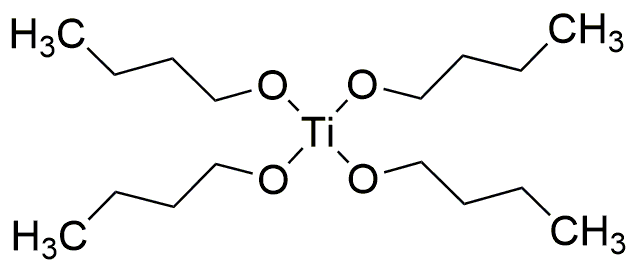Tetrabutyl orthotitanate is widely utilized in research focused on various applications:
- Coatings and Adhesives: This compound serves as a precursor for titanium dioxide in coatings, providing enhanced durability and resistance to UV light, making it ideal for outdoor applications.
- Ceramics Manufacturing: It is used in the production of advanced ceramics, improving mechanical properties and thermal stability, which is crucial for industries like aerospace and automotive.
- Biomedical Applications: Tetrabutyl orthotitanate is explored for use in biocompatible materials, particularly in dental and orthopedic implants, due to its favorable interaction with biological tissues.
- Nanotechnology: This compound is instrumental in synthesizing titanium-based nanoparticles, which have applications in drug delivery systems and as catalysts in chemical reactions.
- Environmental Remediation: It is being studied for its potential in removing heavy metals from wastewater, offering a sustainable solution for industries looking to minimize their environmental impact.
General Information
Properties
Safety and Regulations
Applications
Tetrabutyl orthotitanate is widely utilized in research focused on various applications:
- Coatings and Adhesives: This compound serves as a precursor for titanium dioxide in coatings, providing enhanced durability and resistance to UV light, making it ideal for outdoor applications.
- Ceramics Manufacturing: It is used in the production of advanced ceramics, improving mechanical properties and thermal stability, which is crucial for industries like aerospace and automotive.
- Biomedical Applications: Tetrabutyl orthotitanate is explored for use in biocompatible materials, particularly in dental and orthopedic implants, due to its favorable interaction with biological tissues.
- Nanotechnology: This compound is instrumental in synthesizing titanium-based nanoparticles, which have applications in drug delivery systems and as catalysts in chemical reactions.
- Environmental Remediation: It is being studied for its potential in removing heavy metals from wastewater, offering a sustainable solution for industries looking to minimize their environmental impact.
Documents
Safety Data Sheets (SDS)
The SDS provides comprehensive safety information on handling, storage, and disposal of the product.
Product Specification (PS)
The PS provides a comprehensive breakdown of the product’s properties, including chemical composition, physical state, purity, and storage requirements. It also details acceptable quality ranges and the product's intended applications.
Certificates of Analysis (COA)
Search for Certificates of Analysis (COA) by entering the products Lot Number. Lot and Batch Numbers can be found on a product’s label following the words ‘Lot’ or ‘Batch’.
*Catalog Number
*Lot Number
Certificates Of Origin (COO)
This COO confirms the country where the product was manufactured, and also details the materials and components used in it and whether it is derived from natural, synthetic, or other specific sources. This certificate may be required for customs, trade, and regulatory compliance.
*Catalog Number
*Lot Number
Safety Data Sheets (SDS)
The SDS provides comprehensive safety information on handling, storage, and disposal of the product.
DownloadProduct Specification (PS)
The PS provides a comprehensive breakdown of the product’s properties, including chemical composition, physical state, purity, and storage requirements. It also details acceptable quality ranges and the product's intended applications.
DownloadCertificates of Analysis (COA)
Search for Certificates of Analysis (COA) by entering the products Lot Number. Lot and Batch Numbers can be found on a product’s label following the words ‘Lot’ or ‘Batch’.
*Catalog Number
*Lot Number
Certificates Of Origin (COO)
This COO confirms the country where the product was manufactured, and also details the materials and components used in it and whether it is derived from natural, synthetic, or other specific sources. This certificate may be required for customs, trade, and regulatory compliance.

